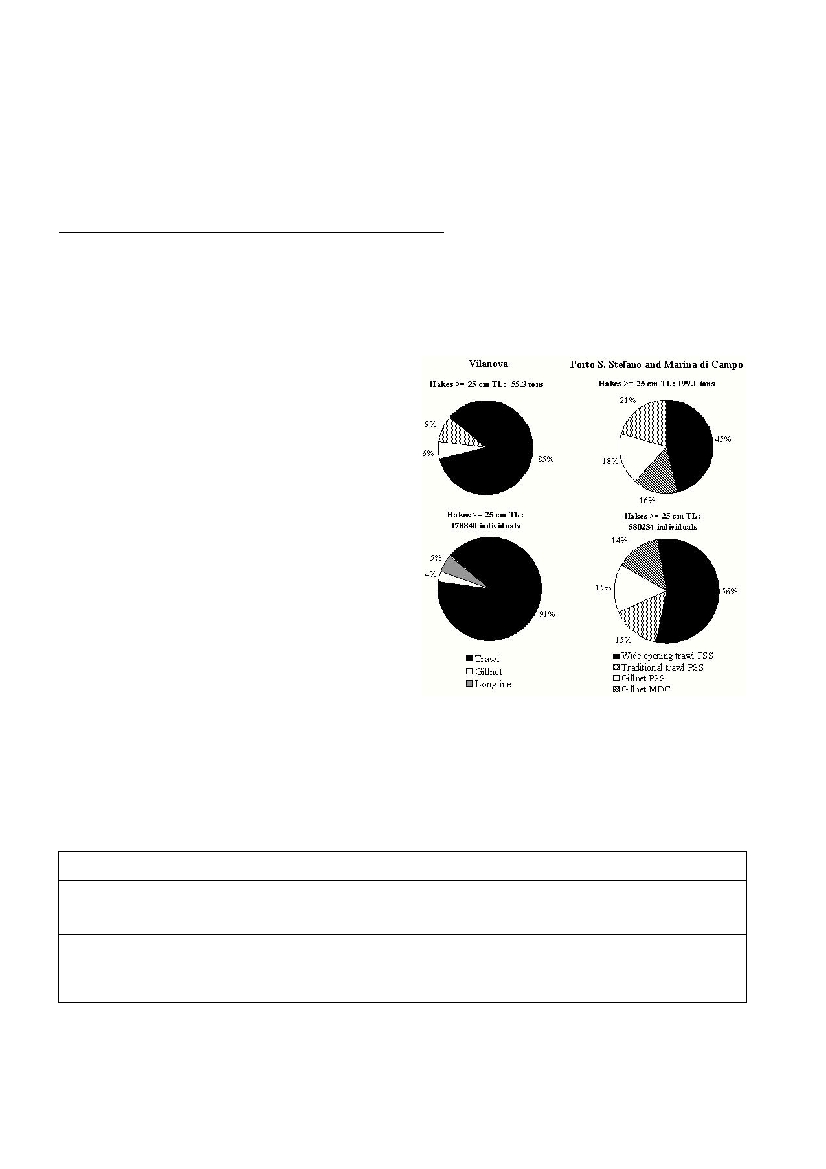Rapp. Comm. int. Mer Médit., 36,2001
321
Introduction
The European hake, M. merluccius, (L., 1758), is one of the most
important species exploited by the Mediterranean demersal fisheries.
In order to improve the knowledge on the exploitation of this species,
a study on the impact of different gears on the adult population was
carried out following the activity of the fishing ?eets in two north-
western Mediterranean areas, the Catalan Sea and the northern
Tyrrhenian Sea. This work has been carried out in the framework of
investigations funded by the European Union, in particular the FAIR
project 97-3522 ("Llucet").
Material and methods
In the years 1998-'99, on a monthly basis, information on landings,
fishing effort and demographic structure of the European hake was
collected by port and gear. In the Catalan Sea the ?eet of Vilanova i la
Geltrú was studied (traditional trawling, gillnet, longline), while in the
northernTyrrhenian Sea those of Porto Santo Stefano (traditional
trawling, wide opening trawling and gillnet) and Marina di Campo
(gillnet) were followed. Data were collected by different approaches:
directly at the auction, from official archives, by samplings on board,
by monitoring and inquires at the landing points, and by the distribu-
tion of log books. Length frequencies were obtained measuring (Total
Length, TL, to the lowest 0.5 cm) representative samples of the month-
ly landings of each gear. In order to a better comparison of the results,
a one year data period (January '99-December '99 for Vilanova,
November '98-October '99 for the northern Tyrrhenian Sea) was sub-
sequently chosen for all the foreseen analysis. The study was focused
on the specimens bigger than 25 cm TL, considered to represent the
adult population of M. merluccius, taking in account the biological
characteristics of this species (1).
Results and discussion
Table 1 resumes the characteristics of the ?eets targeting hake in the
studied period. M. merlucciuswas one of the targets of the multispe-
cific catch of trawling, while it was the most important objective of
gillnet and longline, especially from autumn to spring.
During the one year period considered, a total of 150 tons of hake
was estimated to be landed by the ?eet of Vilanova, 435 by the ?eets
of Porto Santo Stefano and Marina di Campo (Tab. 1)
The adults of M. merlucciusrepresented a percentage between 37 and
46% of the total landings of this species, with 55.3 and 199.1 tons in the
t
wo areas. Tr
awling resulted the gear accounting for the majority of hake
landings, with the 95% and 83% of the total biomass landed, in the
Catalan and Northern Tyrrhenian Sea, respectively (Ta
b. 1). The contri-
bution of the artisanal gears, negligible for the total hake landings, wa
s
noticeable when the adults were considered : gillnet and longline of
Vi
l
a
n
ova represented the 15% of the biomass landed of this demo-
graphic fraction, gillnets of Porto Santo Stefano and Marina di Campo
accounted for 34% in Northern Tyrrhenian Sea (Ta
b. 1 and Fig. 1). T
h
e
predominance of trawling in providing the landings of hake was also
due to the greater fishing effort performed by the ?eet using this gear.
For example, in the ports of northern Tyrrhenian Sea 31 trawlers wo
r
ke
d
in the studied year on average 5 days each week, in comparison with the
15 vessels with gillnet (Ta
b. 1) working on a seasonal basis and with
l
a
rge periods of inactivity due to the adverse weather conditions.
Fig. 1 - Composition of the annual landings of adults of M. mer-
luccius, by gear and port
In spite of this, the landings per unit effort of adult hakes (LPUE, kg
per fishing day per boat) of artisanal gears were higher respect those
of trawling (Fig. 2). Moreover, in both areas it was observed a season-
al pattern in the LPUEs; trawling reached a maximum in the late
spring-summer, while the artisanal gears showed, in general, the high-
est values in winter and autumn, with the exception of the peak in
April showed by the gillnet of Porto Santo Stefano.
ANALYSIS OF THE IMPACT OF THE FISHERY ON THE ADULT POPULATION OF EUROPEAN HAKE
IN THE NORTHWESTERN MEDITERRANEAN
Sartor P.
1
*, Recasens L.
2
,Viva C.
3
, Lleonart J.
2
1
Dip. Scienze Uomo Ambiente, Pisa, Italy
2
Institut de Ciéncies del Mar (CSIC), Barcelona, Spain
3
Centro Interuniversitario Biologia Marina ed Ecologia Applicata (CIBM), Livorno, Italy.
Abstract
The impact of the fishery on the adult population of Merluccius merlucciuswas studied in two areas of the north-western Mediterranean.
From the analysis of the commercial landings and of the corresponding size structures, appreciable differences in the exploitation pattern
of the different fishing gears were evidenced.
Keywords : fisheries, demersal, population dynamics, fishes, Tyrrhenian Sea.
N° of
G.R.T.
Kw
Hake Landings (tons)
Boats
TotalMean (± SD)TotalMean (± SD)Total (%)Adults (%)
a) Catalan Sea – Vilanova
Trawl
26
918
35(±24)4253164(±152)142.5 (95)47.8 (86)
Longline
6
59
9(±6)
402
67(±31)4.5 (3)4.5 (9)
Gillnet
9
36
4(±2)
339
50(±38)3.0 (2)3.0 (6)
b) Northern Tyrrhenian Sea – Porto Santo Stefano and Marina di Campo
Trad. trawling PSS
15
618
41(±30)4272305 (±138) 116.5 (27)41.0 (21)
Wide op. trawling PSS16
775
48(±12)5461390 (±116)241.8 (56)91.6 (45)
Gillnet PSS
5
62
12(±5)
627125(±26)35.3 (8)35.2 (18)
Gillnet MDC
15
163
11(±5)
1855124(±34)41.1 (9)31.3 (16)
Table 1. Characteristics of the fishing ?eets and annual landings of M. merluccius.

